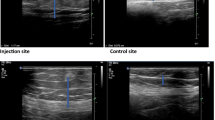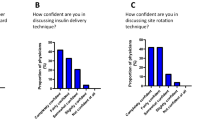Abstract
The aim of our study was to assess whether a non-invasive insulin injector could improve the metabolic control of ten diabetic children complaining of painful injections with syringe and needle. The cumulative study period amounted to 1347 days. Whereas a non-significant rise in insulin needs was observed (from 0.98±0.03 to 1.03±0.06 units/kg per day, mean ± sem), mean HbA1c value remained unchanged (8.9%±0.4% vs 9.0%±0.5%). Jet injections were felt as less painful than those using syringe and needle (nine out of ten cases). This advantage was hampered by side-effects in eight out of ten cases such as episodes of glycoketonuria (six out of ten cases) leading to hospitalization in three patients. Other side-effects included inability to adjust injection pressure (four out of ten cases) and technical failure requiring an exchange of injector in five cases. The four children with most serious problems were significantly younger (P=0.009) than other subjects. In conclusion, this type of injector should be discouraged in young diabetic children. For older children and adolescents, it may be an alternative to syringe and needle provided repeated detailed information and tight medical supervision is available.
Similar content being viewed by others
References
Burger W, Weber B, Hovener G, Enders I, Hartmann R (1988) Prevalence and risk factors of retinopathy in young type I diabetic patients. In: Weber B (ed) Early vascular complications in children with diabetes mellitus. Pediatric and Adolescent Endocrinology, Karger, Basel 17:128–137
Chiasson J-L, Ducros F, Poliquin-Hamet M, Lopez D, Lecavalier L, Hamet P (1984) Continuous subcutaneous insulin infusion (Mill-Hill infuser) versus multiple injections (Medi-Jector) in the treatment of insulin-dependent diabetes mellitus and the effect of metabolic control on microangiopathy. Diabetes Care 7:331–337
Cramer B, Feihl F, Palacio Espasa F (1979) Le diabète juvénile, maladie difficile à vivre et à penser: étude psychiatrique multifocale d'enfants diabétiques. Psychiatr Enfant 22:1–66
Danowski TS, Sunder JH (1987) Jet injection of insulin during self-monitoring ob blood glucose. Diabetes Care 1:27–33
Editorial (1985) Jet injection of insulin. Lancet I: 1140
Hallé J-P., Lambert J, Lindmayer I, Menassa K, Coutu F, Moghrabi A, Legendre L, Legault C, Lalumiére G (1986) Twice daily mixed regular and NPH insulin with new jet injector versus conventional syringes: pharmacokinetics of insulin absorption. Diabetes Care 9:279–282
Hingson RA, Hughes JG (1947) Clinical studies with jet injections: new method of drug administration. Anesth Analg 26: 221–230
Houtzagers CM, Berntzen PA, Stap H van der, Veer EA van der (1988) Absorption kinetics of short- and intermediate-acting insulins after jet injection with Medi-Jector II. Diabetes Care 11:739–742
Lindmayer I, Menassa K, Lamber J, Moghrabi A, Legendre L, Legault C, Letendre M, Hallé J-P (1986) Development of new injector for insulin therapy. Diabetes Care 9:294–297
Lucas A, Ribas L, Salinas I, Audi L, Sanmarti A, Foz M (1988) Insulin levels after injection by stream and disposable syringe. Diabetes Care 11:298–299
Ludvigsson J, Richt B (1989) Sociopsychological complications of getting diabetes mellitus in childhood. In: Laron Z, Karp M (eds) Prognosis of diabetes in children. Pediatric and Adolescent Endocrinology, Karger, Basel, 18:252–258
Malone JI, Lowitt S, Grove NP, Shah SC (1986) Comparison of insulin levels after injection by jet stream and disposable insulin syringe. Diabetes Care 9:637–640
Pehling GB, Gerich JE (1984) Comparison of plasma insulin profiles after subcutaneous administration of insulin by jet spray and conventional needle injection in patients with insulin-dependent diabetes mellitus. Mayo Clin Proc 59:751–754
Perkins FS, Todd GM, Brown TM, Abbott HT (1950) Jet injection of insulin in treatment of diabetes mellitus. Proc Am Diabetes Assoc 10:185–199
Sempé M, Pédron G (1970) Croissance somatique des filles et des garçons de la naissance à 19 ans. Etudes sur la Croissance, Paris
Tattersall RB, Gale E (1981) Patient self-monitoring of blood glucose and refinement of conventional insulin treatment. Am J Med 70:177–182
Taylor R, Home PD, Alberti KGMM (1981) Plasma free insulin profiles after administration of insulin by jet and conventional syringe injection. Diabetes Care 4:377–379
Weber R, Burger W, Hartmann R, Hovener G, Malchus R, Oberdisse U (1986) Risk factors for the development of retinopathy in children and adolescents with type I (insulin-dependent) diabetes mellitus. Diabetologia 29:23–29
Weller C, Linder M (1966) Jet injection of insulin vs the syringe and needle method. JAMA 195:156–159
Worth R, Anderson J, Taylor R, Alberti KGMM (1980) Jet injection of insulin: comparison with conventional injection by syringe and needle. Br Med J 281:713–714




